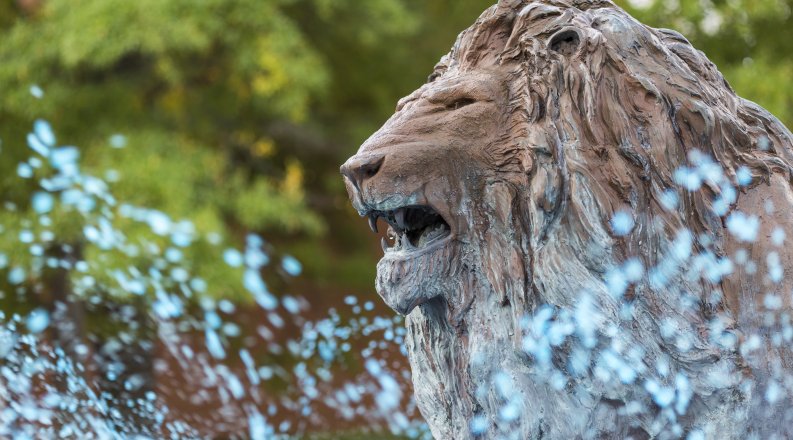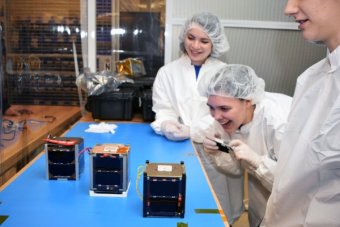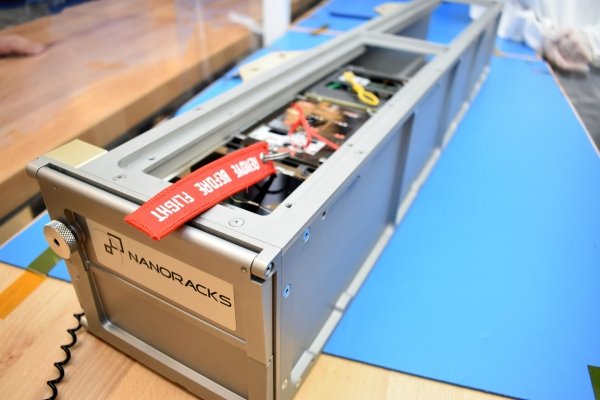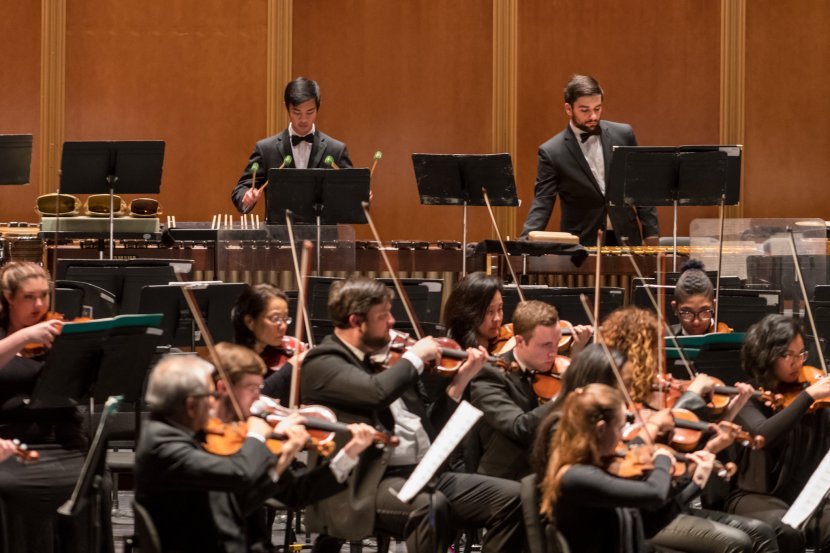After successful integration with deployer in Houston, CubeSat is scheduled to launch from NASA's Wallops Island facility on April 17.
Three nano-satellites, each about 4 inches cubed and weighing approximately 3 pounds, have been developed and instrumented (one each at ODU, Virginia Tech and Virginia) to obtain measurements of the properties of the Earth's atmosphere.
By Keith Pierce
A team of Old Dominion University students took a giant leap toward space as they joined two other Virginia universities in delivering their CubeSats to NanoRacks in Houston on Feb. 26. The nano-sized cube satellites were successfully integrated into the company's commercially developed NanoRacks CubeSat Deployer (NRCSD) in preparation for launch on Northrop Grumman's Antares to the International Space Station. The launch is scheduled for April 17 from NASA's Wallops Flight Facility.
Kimberly Wright, a graduate student in Mechanical and Aerospace Engineering, serves as student mission manager for ODU. She was accompanied by her teammates, Mechanical and Aerospace Engineering master's student Westin Messer and Electrical Engineering master's student Anthony Cappiello, as well as their faculty advisor, associate professor of Electrical and Computer Engineering Dimitrie Popescu. Wright was thrilled to finally hand off ODU's CubeSat for this critical step in a multiyear journey.
"It's exciting to see that all of our hard work, all of the hurdles we had to overcome and all the long nights in the lab has really paid off," she said. "In Houston, we said goodbye to our CubeSat for the last time."
The satellites are part of the Virginia CubeSat Constellation mission, a collaborative project of the Virginia Space Grant Consortium (VSGC) and four of its member universities: ODU, Virginia Tech, Virginia and Hampton University. Three nano-satellites, each about 4 inches cubed and weighing approximately 3 pounds, have been developed and instrumented (one each at ODU, Virginia Tech and Virginia) to obtain measurements of the properties of the Earth's atmosphere. As the orbits of the satellites decay due to atmospheric drag, satellite instruments will quantify atmospheric density.
"Starting in undergrad, we were able to experience working across different universities, U.Va. and Virginia Tech, which both have great engineering programs," Wright said. "To be able to work with these two universities to build, deliver and integrate is really incredible, and I think it helps people recognize that ODU is becoming one of the big state schools for the space program."
The three CubeSats will be deployed via the NRCSD by astronauts aboard the International Space Station into orbit near-simultaneously so they can orbit together and function as a constellation. The ODU satellite, which has a drag brake to intentionally cause orbital decay, is expected to remain in orbit for up to four months. The other two satellites should orbit for up to two years at an altitude of 250 miles before burning up when they re-enter Earth's atmosphere. The satellites will communicate data to ground stations at Virginia Tech, U.Va. and ODU for analysis using a tool being developed by Hampton students from the Atmospheric and Planetary Science Department.
The students have named their satellites after the Roman goddesses on the back of the Virginia state seal, who represent the blessings of freedom and peace. U.Va. has chosen Libertas, the goddess of individual liberties; Virginia Tech selected Ceres, the goddess of agriculture; and Old Dominion chose Aeternitas, the goddess representing eternity.
"The handover brings the team in sight of seeing their satellites readied for launch," said Mary Sandy, Director of VSGC. "Engaging students in real-world space missions offers them exciting educational opportunities that provide critical workplace skills. By taking on actual mission roles and going through NASA design and flight-readiness reviews, students are learning how space missions are done and how to deal with the unique challenges of the space environment."
More than 140 undergraduate students have worked on the mission since June 2016 as a cross-institutional team. Undergraduate student leaders and team members from physics, electrical engineering, aerospace engineering, mechanical engineering and chemical engineering disciplines have made the mission a reality.
"Students have been coached by faculty advisors and have benefitted greatly from advice from NASA, industry and academic advisors," Sandy said. "They have also received excellent guidance from NanoRacks, the world's leading commercial space station company. Doing technology demonstration and research in space is a great thing for students to have on their resumes."
The project is administered by VSGC, based in Hampton, and funded by NASA's Undergraduate Student Instrument Program, as well as VSGC. The project is managed for NASA by its Wallops Flight Facility on Virginia's Eastern Shore.
Related News Stories
VBOC Director Heads to Washington to Testify About Small Business Program Effectiveness
Cherylynn Sagester, director of ODU’s Veterans Business Outreach Center, to discuss small business program effectiveness Feb. 27. (More)
ODU Researchers at Jefferson Lab Take a Big Step Toward Solving a Decades-Old Mystery
Lawrence Weinstein, professor and Eminent Scholar of physics, has written an article about the international collaboration for the current edition of Nature. (More)
Old Dominion University and Virginia Symphony Orchestra Sign Collaborative Agreement
The organizations are combining efforts to enhance music education in Hampton Roads. (More)








